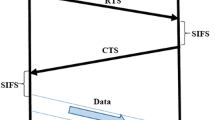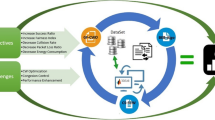Abstract
In many studies aimed at improving the quality of service (QoS) in wireless local area networks (WLAN), the performance was improved by applying non-ACK model, physical interference model, analytical models etc. with using optimization algorithms with stable simulations. For efficient QoS in WLANs, performance is generally increased using 802.11n medium access control protocol through request to send threshold value (RSTV), fragmentation threshold value (FTV) and buffer size (BS) parameters. While the RSTV activates the request to send/clear to send (RTS/CTS) mechanism in carrier sense multiple access with collision avoidance (CSMA/CA) protocol, FTV fragments the larger packets during CSMA/CA transmission, reducing the packet loss in WLANs. BS, however, is the memory used in the CSMA/CA model to reduce cost. In previous studies, most of the new model applied in process layers by using Riverbed Modeler simulation tool and ideal input values had been obtained for RSTV, FTV and BS during the simulation stable. In this study, a new model proposed for CSMA/CA protocol on the process layers which used feedback controlled method with fuzzy logic to improve QoS during the simulation. Values obtained with nearly six million different test results, has been revealed that throughput was increased by 26.48%, the channel utilization by 2.30%, the data traffic received by 14.59% and the data traffic sent by 17.06% respectively. While RSTV, FTV and BS input parameters are optimized with the help of the feedback controlled algorithm used in these studies, the effects of external parameters such as number of nodes, inter-arrival time, transmitting power etc. on the performance improvements in the model are demonstrated in graphics. All these test results have shown that the new model provides a high rate of performance improvement for WLANs.

















Similar content being viewed by others
References
Singh, H., Singh, T., & Kaur, M. (2014). Improving the quality of service of EDCF over DCF for real time applications using probability algorithm. IJARCCE, 3–4, 6330–6333.
Dalvi, A., Svamy, P., & Meshram, B.B. (2011). DCF improvement for satisfactory throughput of 802.11 WLAN, IJCSE, 3–7 (pp. 2862–2868).
Borsuk, B., & Koçak, C. (2016). RTS/CTS mechanism’s effect on performance in multimedia applications when hidden node problem occurs on wireless networks. International Journal Of Informatics Technologies, 9–2, 187–195.
Yun, J.H., & Seo, S.W. (2007). Novel collision detection scheme and its applications for IEEE 802.11 wireless LANs. Computer Communication, 30, 1350–1366.
Kocak, C., & Karakurt, H. B. (2019). Fuzzy logic-based performance improvement on MAC layer in wireless local area networks. Neural Computing and Applications, 31, 6113–6128.
Kocak, C., & Karakurt, H. B. (2019). Data traffic optimization in wireless local area networks with artificial neural networks. Journal Of Polytechnic, 22–3, 737–747.
Malik, S., Chaudhary, R., Pathak, A., Chakraborty, S.P. (2015). Modeling and analysis of IEEE 802.11 DCF MAC. In 3rd international conference on recent trends in computing. Procedia computer science (Vol. 57, pp. 473–482).
Choi, S., Prado, J. D., Shankar, N. S., & Mangold, S. (2003) IEEE 802.11e contention-based channel access (EDCF) performance evaluation. In IEEE International Conference on Communications, 2003. ICC '03. IEEE (2003). https://doi.org/10.1109/ICC.2003.1204546.
Kaur, I., Bala, M., & Bajaj, H. (2012). Performance evaluation of WLAN by varying PCF, DCF and enhanced DCF slots to improve quality of service. IOSRJCE, 2–5, 29–33.
Karakurt, H. B., & Kocak, C. (2015). On wireless network PCF, DCF and EDCF with fragmentation threshold. In XVII. Academic Informatics Conference Eskisehir/Turkey
Sidelnikov, A., Yu, J., & Choi, S. (2006). Fragmentation/Aggregation scheme for throughput enhancement of IEEE 802.11n WLAN. In Proceedings of IEEE APWCS.
Preveze, B. (2011). Cognitive methods in multimedia communications. Dissertation, University of Baskent
Prithi, S., & Sumathi, S. (2020). LD2FA-PSO: a novel learning dynamic deterministic finite automata with PSO algorithm for secured energy efficient routing in Wireless Sensor Network. Ad Hoc Networks, 97, 1–14.
Poornima, G. A., & Paramasivan, B. (2020). Anomaly detection in wireless sensor network using machine learning algorithm. Computer Communications, 151, 331–337.
Fanian, F., & Rafsanjani, M. K. (2020). A new fuzzy multi-hop clustering protocol with automatic rule tuning for wireless sensor networks. Applied Soft Computing, 89, 1–24.
Zhao, X. W., Hai, L. X., & Wei, D. (2008). A fuzzy logic cooperative MAC for MANET. The Journal Of China Universities Of Posts And Telecommunications, 15–1, 55–60.
Frantti, T., & Koivula, M. (2011). Fuzzy packet size control for delay sensitive traffic in ad hoc networks. Expert Systems with Applications, 38, 10188–10198.
Collotta, M. (2015). FLBA: A fuzzy algorithm for load balancing in IEEE 802.11 network. Journal of Network and Computer Applications 53, 183–192.
Yu, Y., Wang, T., & Liew, C. (2018). Deep-reinforcement learning multiple access for heterogeneous wireless networks. IEEE Journal On Selected Areas In Communications, 37–6, 1277–1290.
Bhattacharyya, R., Bura, A., Rengarajan, D., Rumuly, M., Shakkottai, S., Kalathil, D., Mok, R. K. P., Dhamdhere, A. (2019). QFlow: A reinforcement learning approach to high QoE video streaming over wireless networks. In ’19 Proceedings of the twentieth ACM international symposium on mobile ad hoc networking and computing (pp. 251–260).
Yang, J., You, X., Wu, G., Hassan, M. M., Almogren, A., & Guna, J. (2019). Application of reinforcement learning in UAV cluster task scheduling. Future Generation Computer Systems, 95, 140–148.
Li, F., Chen, Y., Wang, J., Zhou, X., & Tang, B. (2019). A reinforcement learning unit matching recurrent neural network for the state trend prediction of rolling bearings. Measurement, 145, 191–203.
You, C., Lu, J., Filev, D., & Tsiotras, P. (2019) Advanced planning for autonomous vehicles using reinforcement learning and deep inverse reinforcement learning. Robotics and Autonomous Systems, 114, 1–18.
Yao, H., Chen, X., Li, M., Zhang, P., & Wang, L. (2018). A novel reinforcement learning algorithm for virtual network embedding. Neurocomputing, 284, 1–19.
Bandırmalı, N., Ertürk, İ., Çeken, C., & ve Bayılmış, C. (2008). Providing security service with skipjack encryption method for delay sensitive and energy aware wireless sensor networks. In Electrical and electronics and computer engineering symposium, ELECO’08 (pp. 152–157).
Gamal, M., Sadek, N., Rizk, M. R. M., & Ahmed, M. A. E. (2020). Optimization and modeling of modified unslotted CSMA/CA for wireless sensor networks. Alexandria Engineering Journal, 59, 681–691.
Mawlawi, B., Dore, J. B., Lebedev, N., & Gorce, J. M. (2014). Performance evaluation of multiband CSMA/CA with RTS/CTS for M2M communication with finite retransmission strategy. Procedia Computer Science, 40, 108–115.
Mahmood, D., Khan, Z. A., Qasim, U., Naru, M. U., Mukhtar, S., Akram, M. I., & Javaid, N. (2014). Analyzing and evaluating contention access period of slotted CSMA/CA for IEEE802.15.4. Procedia Computer Science, 34, 204–115.
Uddin, M. F. (2021). Downlink performance analysis of a CSMA based WLAN under physical interference model. Computer Networks, 196(108255), 1–18.
Touijer, B., Maissa, Y. B., & Mouline, S. (2021). IEEE 802.15.6 CSMA/CA access method for WBANs: Performance evaluation and new backoff counter selection procedure. Computer Networks, 188, 107759 pp. 1–17.
Karakurt, H. B., & Kocak, C. (2015). Performance improvement with fragmentation threshold for the co-ordination functions by using wireless local area. Dissertation, University of Gazi.
Isizoh, A. N., Anazia, A. E., Okide, S. O., Okwaraoka, C. A. P., & Onyeyili, T. I. (2013). Effects of different fragmentation thresholds on data dropped and retransmission attempts in a wireless local area network. IJERA, 3–2, 76–79.
Wang, Q., & Yuan, D. (2010). An adaptive backoff algorithm for IEEE 802.11 DCF with cross-layer optimization. In 2010 6th ınternational conference on. WiCOM. https://doi.org/10.1109/WICOM.2010.5601153
Zhai, H., Kwon, Y., & Fang, Y. (2004). Performance analysis of IEEE 802.11 MAC protocols in wireless LANs. Wireless Communications and Mobile Computing 4, 917–931.
Li, T. (2007). Improving performance for CSMA/CA based wireless networks. Dissertation, National University of Ireland.
Malone, D., Clifford, P., & Douglas, J. L. (2006). On buffer sizing for voice in 802.11 WLANs. IEEE Communications Letters, 10–10, 701–703.
Li, T., Leith, D., Malone, D. (2011). Buffer sizing for 802.11 based networks. IEEE/ACM Transactions on Networking, 156–169.
Vadiati, M., Moghaddam, A. A., Nakhaei, M., Adamowski, J., & Akbarzadeh, A. H. (2016). A fuzzy-logic based decision-making approach for identification of groundwater quality based on groundwater quality indices. Journal of Environmental Management, 184, 255–270.
Kustiawan, I., & Chi, K. H. (2015). Handoff decision using a kalman filter and fuzzy logic in heterogeneous wireless networks. IEEE Communications Letters, 19–12, 2258–2261.
Author information
Authors and Affiliations
Corresponding author
Additional information
Publisher's Note
Springer Nature remains neutral with regard to jurisdictional claims in published maps and institutional affiliations.
Rights and permissions
Springer Nature or its licensor (e.g. a society or other partner) holds exclusive rights to this article under a publishing agreement with the author(s) or other rightsholder(s); author self-archiving of the accepted manuscript version of this article is solely governed by the terms of such publishing agreement and applicable law.
About this article
Cite this article
Karakurt, H.B., Koçak, C. Increasing quality of service in wireless local area networks through fuzzy logic based feedback control method. Wireless Netw 29, 2217–2233 (2023). https://doi.org/10.1007/s11276-023-03293-w
Accepted:
Published:
Issue Date:
DOI: https://doi.org/10.1007/s11276-023-03293-w




